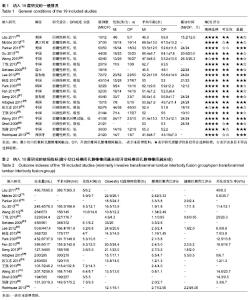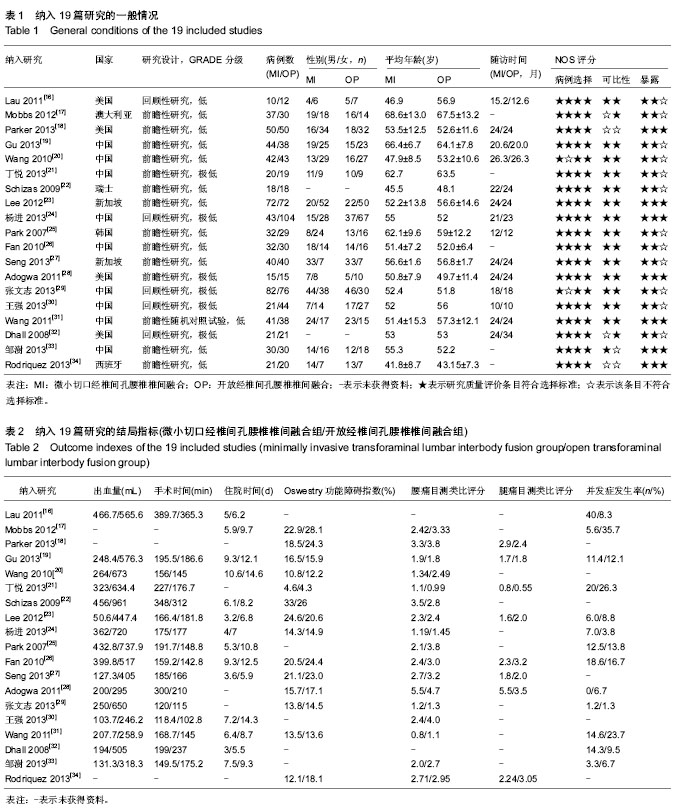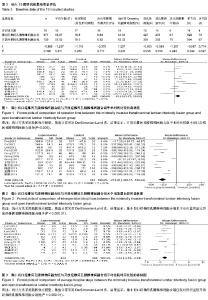Chinese Journal of Tissue Engineering Research ›› 2014, Vol. 18 ›› Issue (22): 3542-3550.doi: 10.3969/j.issn.2095-4344.2014.22.018
Previous Articles Next Articles
Minimally invasive versus open transforaminal lumbar interbody fusion for lumbar degenerative disease: a meta-analysis
Ran Bing, Yan Lei, Zhao Xiao-lei, Xie Yuan-long, Cai Lin
- Fourth Department of Orthopedics, Zhongnan Hospital of Wuhan University, Wuhan 430071, Hubei Province, China
-
Revised:2014-04-25Online:2014-05-28Published:2014-05-28 -
Contact:Cai Lin, M.D., Professor, Chief physician, Fourth Department of Orthopedics, Zhongnan Hospital of Wuhan University, Wuhan 430071, Hubei Province, China -
About author:Ran Bing, Studying for master’s degree, Fourth Department of Orthopedics, Zhongnan Hospital of Wuhan University, Wuhan 430071, Hubei Province, China
CLC Number:
Cite this article
Ran Bing, Yan Lei, Zhao Xiao-lei, Xie Yuan-long, Cai Lin. Minimally invasive versus open transforaminal lumbar interbody fusion for lumbar degenerative disease: a meta-analysis[J]. Chinese Journal of Tissue Engineering Research, 2014, 18(22): 3542-3550.
share this article

2.1 纳入研究的基本特征及质量评价 初检出相关文献 1 563篇,其中中文文献862篇,英文文献701篇。排除动物实验、重复发表及明显不符合纳入标准的文献后,经阅读文题和摘要初筛纳入112篇文献。进一步查找和阅读全文,严格按照纳入与排除标准筛选最终纳入19篇文献[16-34],共1 400例患者;其中英文文献14篇,中文文献5篇。微小切口经椎间孔腰椎椎间融合组621例,单节段融合529例,多节段融合73例,未说明融合节段19例;微小切口经椎间孔腰椎椎间融合组729例,单节段融合594例,多节段融合67例,未说明融合节段68例。 采用NOS量表对纳入的19篇文献进行质量评价[35],其中4篇文献8个评价条目均为优“★”属高质量研究;9篇文献8个评价条目中仅有1个条目评价为差“☆”属质量较高的研究;6篇文献8个条目中有2个条目质量评价为差“☆”属质量中等的研究。纳入研究的基本特征、文献质量评价见表1-3。 2.2 Meta分析结果 2.2.1 术中变量 19篇纳入研究中12篇报道了手术时间和术中出血量,故纳入12篇文献数据进行分析[20-21,23-27,29-31,33]。手术时间异质性检验结果显示各研究间异质性较大[MD= 12.19,95%CI(3.73,20.65),P < 0.000 01,I2=85%],故采用随机效应模型合并敏感性分析, 结果显示,开放经椎间孔腰椎椎间融合组手术时间较微小切口经椎间孔腰椎椎间融合组短,两组差异有显著性意义(P=0.005,图1)。术中出血量异质性结果示,各研究间异质性较大[MD= -271.05,95%CI(-345.17,-196.93),P < 0.000 01,I2=97%],故采用随机效应模型分析,结果显示,微小切口经椎间孔腰椎椎间融合组术中出血量明显比开放经椎间孔腰椎椎间融合组少,两组差异有显著性意义(P < 0.000 01,图2)。 2.2.2 治疗后近期疗效 11个研究报道了平均住院时 间[17,19-20,23-27,30-31,33],故纳入11个研究的数据进行分析。异质性结果显示各研究异质性明显[MD=-3.32,95%CI (-4.16,-2.48),P < 0.000 1,I2=93%],故采用随机效应模型进行敏感性合并分析,结果显示,微小切口经椎间孔腰椎椎间融合组住院时间明显较开放经椎间孔腰椎椎间融合组短,二者差异有显著性意义(P < 0.000 01),说明微小切口经椎间孔腰椎椎间融合组患者早期恢复更好(图3)。"


其他早期恢复指标较少被报道,有7个研究比较了两组治疗后镇痛药应用时间和剂量、引流量,及治疗后下床活动时间、开始工作时间[19,23,25-26,31-33],结果显示微小切口经椎间孔腰椎椎间融合组优于开放经椎间孔腰椎椎间融合组。 2.2.3 治疗后远期疗效 17篇文献报道了末次随访(>10个月)的腰痛目测类比评分[17-31,33-34],7篇文献报道了末次随访(>10个月)的腿痛目测类比评分[18-19,21,23,27-28,34],13篇文献报道了末次随访(>10个月)ODI[17-21,23-24,25-29,31,34],故纳入报道文献的数据进行分析。腰痛目测类比评分异质性检验结果显示各研究间异质性明显[MD=-0.54,95%CI(-0.79,-0.28),P < 0.000 1,I2=86%],故采用随机效应模型进行敏感性合并分析,结果示,微小切口经椎间孔腰椎椎间融合组腰背痛缓解率远期效果优于开放经椎间孔腰椎椎间融合组,两组差异有显著性意义(P < 0.0001,图4)。 腿痛目测类比评分异质性检验结果显示各研究间异质性明显[MD=-0.00,95%CI(-0.38,-0.38),P < 0.000 1,I2=81%],故采用随机效应模型进行敏感性合并分析,结果示,微小切口经椎间孔腰椎椎间融合组与开放经椎间孔腰椎椎间融合组腿痛远期缓解率差异无显著性意义(P=1.0,图5)。ODI异质性检验结果显示各研究间异质性较明显[MD= -1.03,95%CI(-1.87,-0.18),P=0.000 6,I2=65%],故采用随机效应模型行敏感性合并分析,结果示, 微小切口经椎间孔腰椎椎间融合组略优于开放经椎间孔腰椎椎间融合组,组间差异有显著性意义(P=0.02,图6)。 2.2.4 并发症 17篇文献报道了术后并发症[16-17,19-33],报道的并发症包括伤口感染,术后神经损伤,硬膜粘连、破裂,内固定松动、断裂、Cage移位和骨不连等,故纳入17篇文献进行分析。并发症异质性结果显示各研究间异质性较小[MD=0.74,95%CI(0.51,1.08),P=0.64,I2=0%],故采用固定效应模型进行敏感性分析, 结果示,两组治疗后并发症发生率差异无显著性意义(P=0.12,图7)。 2.3 发表性偏倚分析 漏斗图分析结果显示,腰痛目测类比评分、手术时间、住院时间,并发症,ODI的漏斗图集中在图形上部,左右基本对称,表明存在发表偏倚的可能性较小。而术中出血量、3个指标的漏斗图不对称,表明其存在发表偏倚的可能性较大。"

| [1] Cloward RB. History of PLIF:Forty years of personal experience//Lin PM.Posterior lumbar interbody fusion.New York:Springfield,Charles C Thomas,1982:58-71.
[2] 廖晖,李峰,熊伟,等.Wiltse入路和后正中入路治疗腰椎退行性疾病的疗效对比研究[J].骨科,2013,4(4):174-177.
[3] Harms J, Rolinger H. A one-stager procedure in operative treatment of spondylolisthesis: dorsal traction-reposition and anterior fusion. Z Orthop Ihre Grenzgeb.1982;120:343-347.
[4] Foley KT, Gupta SK, Justis JR, et al. Percutaneous pedicle screw fixation of the lumbar spine.Neurosurg Focus. 2001;10: E10.
[5] Foley KT, Holly LT, Schwender JD. Minimally invasive lumbar fusion. Spine.2003;28:S26-S35.
[6] Kaloostian PE,Gokaslan ZL. Evidence-Based Review of Transforaminal Lumbar Interbody Fusion: Is Minimally Invasive Better?.World Neurosurg. 2013;1:117.
[7] Kim DY, Lee SH, Chung SK, et al. Comparison of multifidus muscle atrophy and trunk extension muscle strength: percutaneous versus open pedicle screw fixation. Spine (Phila Pa 1976). 2005;30(1): 123-129.
[8] Wild MH, Gless M, Plieschnegger C, et al. Five-year follow-up examination after purely minimally invasive posterior stabil ization of thoracolumbar fractures: a comparison of minimally invasive percutaneously and conventionally open treated patients. Arch Orthop Trauma Surg. 2007;127(5): 335-343.
[9] Stevens KJ, Spenciner DB, Griffiths KL, et al. Comparison of minimally invasive and conventional open posterolateral lumbar fusion using magnetic resonance imaging and retraction pressure studies. J Spinal Disord Tech. 2006;19(2): 77-86.
[10] Foley KT, Lefkowitz MA. Advances in minimally invasive spine surgery. Clin Neurosurg. 2002;49: 499-517.
[11] Isaacs RE, Podichetty VK, Santiago P, et al. Minimally invasive microendoscopy assisted transforaminal lumbar interbody fusion with instrumentation. J Neurosurg Spine, 2005;(2):98-105.
[12] Schwender JD, Holly LT, Rouben DP, et al. Minimally invasive transforaminal lumbar interbody fusion(TLIF):technical feasibility and innitial results. J Spinal Disord Tech. 2005;(18): 1-6.
[13] Fritzell P, Hagg O, Wessberg P, et al. Chronic low back pain and fusion:a comparison of three surgical technique. A prospective multicenter randomized study from the Swedish lumbar spine study group.Spine (Phila Pa 1976). 2002;27(11): 1131-1141.
[14] Arts MP, Nieborg A, Brand R, et al. Serum creatine phosphokinase asan indicator of muscle injury after various spinal and nonspinal surgical procedures. J Neurosurg. 2007; 7(3): 282-286.
[15] 范顺武,胡志军,方向前,等.小切口与传统开放术式行后路腰椎椎体间融合术对脊旁肌损伤的对比研究[J].中华骨科杂志,2009, 29(11):1000-1004.
[16] Lau D,Lee JG,Han SJ, et al. Complications and perioperative factors associated with learning the technique of minimally invasive transforaminal lumbar interbody fusion(TLIF). J Clin Neurosci. 2011;18(5):624-627.
[17] Mobbs RJ,Sivabalan P,Li J. Minimally invasive surgery compared to open spinal fusion for the treatment of degenerative lumbar spine pathologies. J Clin Neur. 2012; 19(6): 829-835.
[18] Parker SL, Mendenhall SK, Shau DN, et al. Minimally invasive versus open transforaminal lumbar interbody fusion (TLIF) for degenerative spondylolisthesis: comparative effectiveness and cost-utility analysis.World Neurosurg. 2013; Epub ahead of print.
[19] Gu GF,Zhang HL,Fan GX, et al.Comparison of minimally invasive versus open transforaminal lumbar interbody fusionin two-level degenerative lumbar disease. Int Orthop. 2013; Epub ahead of print.
[20] Wang J, Zhou Y, Zhang ZF, et al. Comparison of one-level minimally invasive and open transforaminal lumbar interbody fusion in degenerative and isthmic spondylolisthesis grades 1 and 2. Eur Spine J. 2010; 19: 1780-1784.
[21] 丁悦,货石生,张海龙.小切口经椎间孔神经管减压椎间融合治疗退变性腰椎侧弯性椎管狭窄[J].中国修复重建外科杂志,2013, 27(4):404-408.
[22] Schizas C, Tzinieris N, Tsiridis E, et al. Minimally invasive versus open transforaminal lumbar interbody fusion: evaluating initial experience. Int Orthop. 2009; 33: 1683-1688.
[23] Lee KH, Yue WM, Yeo W, et al. Clinical and radiological outcomes of open versus minimally invasive transforaminal lumbar interbody fusion. Eur Spine J. 2012; 21: 2265-2270.
[24] 杨进,孔清泉,宋跃明,等.微创小切口与开放经椎间孔腰椎椎间融合术治疗单节段腰椎退变疾患的近期疗效比较[J].中国修复重建外科杂志,2013,27(3):262-267.
[25] Park Y,Ha JW.Comparison of one-level posterior lumbar interbody fusion performed with a minimally invasive approach or a traditional open approach. Spine. 2007; 32(5): 537-543.
[26] Fan SW, Zhao X, Zhao FD, et al. Minimally invasive transforaminal lumbar interbody fusion for the treatment of degenerative lumbar diseases. Spine (Phila Pa 1976). 2010; 35: 1615-1620.
[27] Seng C,Siddiqui MA,Wong KP.Five-year outcomes of minimally invasive versus open t ransforaminal lumbar interbody fusion: a matched-pair comparison study. Spine. 2013;38(23):2049-2055.
[28] Adogwa O, Parker SL, Bydon A, et al. Comparative effectiveness of minimally invasive versus open transforaminal lumbar interbody fusion: 2-year assessment of narcotic use, return to work, disability, and quality of life. J Spinal Disord Tech. 2011; 24: 479-484.
[29] 张文志,段丽群,尚希福,等.显微镜辅助下微创经椎间孔腰椎椎间融合术治疗腰椎退行性疾病的疗效观察[J].中国修复重建外科杂志,2013,27(3):268-273.
[30] 王强,吴寅良,朱和平.Mast Quadrant微创通道与开放式经椎间孔腰椎椎间融合术的临床比较[J].脊柱外科杂志,2013,11(5): 288-291.
[31] Wang HL,Lu FZ,Jiang JY. Minimally invasive lumbar interbody fusion via MAST Quadrant retractor versus open surgery: a prospective randomized clinical trial. Chin Med. 2011;124(23): 3868-3874.
[32] Dhall SS, Wang MY, Mummaneni PV. Clinical and radiographic comparison of mini-open transforaminal lumbar interbody fusion with open transforaminal lumbar interbody fusion in 42 patients with long-term follow-up. J Neurosurg Spine. 2008; 9: 560-565.
[33] 邹澍,王建,潘文琦,等.微创与开放经椎间孔腰椎椎间融合术组织创伤相关血清指标的比较研究[J].中国修复重建外科杂志, 2013, 27(8):960-964.
[34] Rodriquez-Vela J,Lobo-EscolarA,Joven E.Clinical outcomes of minimally invasive versus open approach for one-level transforaminal lumbar interbody fusion at the 3- to 4-year follow-up. Eur Spine. 2013;22(12):2857-2863.
[35] Wells G, Shea B, O'connell D, et al. The Newcastle-Ottawa Scale NOS for assessing the quality of nonrandomized studies in meta analyses. Ottawa, Canada: Dept of pidemiology and Community Medicine, University of Ottawa.
[36] 陈耀龙,李幼平,杜亮,等.医学研究中证据分级和推荐强度的演进[J].中国循证医学杂志,2008,8(2):127-133.
[37] Humphreys SC, Hodges SD, Patwardhan AG, et al.Comparison of posterior and transforaminal approaches to lumbar interbody fusion.Spine (Phila Pa 1976). 2001; 26(5): 567-571.
[38] Kawaguchi Y, Matsui H, Tsuji H. Quantitative analysis of the effect of lumbar orthosis on trunk muscle strength and muscle activity in normal subjects. J Orthop Sci.2002;7:483-489.
[39] Gejo R, Matsui H, Kawaguchi Y,et al. Serial changes in trunk muscle perfor-man ce after posterior lumbar surgery. Spine. 1999; 24:1023-1028.
[40] Kramer M, Katzmaier P, Eisele R, et al. Surface electromyography-verified muscular damage associated with the open dorsal approach to the lumbar spine. Eur Spine J. 2001;10(5):414-420.
[41] Sun ZJ,Li WJ,Zhao Y, et al. Comparing minimally invasive and open transforaminal lumbar interbody fusion for treatment of degenerative lumbar disease: a meta-analysis. Chin Med. 2013;126(20):3962-3971.
[42] Peng CW,Yue WM,Poh SY, et al. Clinnical and radiological outcomes of minimally invasive versus open transforaminal lumbar interbody fusion. Spine(Phila Pa 1976). 2009;34(13): 1385-1389.
[43] 康辉,徐峰,蔡贤华,等. 经Quadrant通道微创TLIF治疗腰椎退行性疾病的临床研究[J].颈腰痛杂志,2013,34(4):309-313.
[44] Dong YL, Jung TG, Lee SH. Single-level instrumented mini-open transforaminal lumbar interbody fusion in elderly patients. J Neurosurg Spine. 2008; 9: 137-144.
[45] Karikari IO, Grossi PM, Nimjee SM, et al. Minimally invasive lumbar interbody fusion in patients older than 70 years of age: analysis of peri-and postoperative complications. Neurosurgery. 2011; 68: 897-902.
[46] Wu WJ, Liang Y, Zhang XK, et al. Complications and clinical outcomes of minimally invasive transforaminal lumbar interbody fusion for the treatment of one- or two-level degenerative disc diseases of the lumbar spine in patients older than 65 years. Chin Med J. 2012; 125: 2505-2510. |
| [1] | Ye Xiang-yang, Sun Xiang, Tang Li-xin, Zhen Ping, Geng Bin, Wang Hua-lei, Zhao Yu-guo. Acetabular liner wear of cross-linked versus conventional polyethylene for total hip arthroplasty: a meta-analysis [J]. Chinese Journal of Tissue Engineering Research, 2017, 21(7): 1143-1148. |
| [2] | Sheng Xiao-lei, Yuan Feng, Li Zhi-duo, Yang Yu-ming, Lu Hai-tao, Zhang Jun-wei. Comparison of the accuracy of lower cervical anterior transpedicular screws between three-dimensional printing assembly navigation template and free hand placement [J]. Chinese Journal of Tissue Engineering Research, 2017, 21(3): 406-411. |
| [3] | Wang Xing, Zhang Shao-jie, Shi Jun, Li Xiao-he, Liu Ying, Li Zhi-jun, Hou Er-fei, Chen Jie, Wang Wei. Correlation of uncinate process and various vertebral body structures in adolescents: three-dimensional reconstruction based on CT images [J]. Chinese Journal of Tissue Engineering Research, 2017, 21(3): 412-417. |
| [4] | Du Shi-yao, Zhou Feng-jin, Ni Bin, Chen Bo, Chen Jin-shui. Finite-element analysis of a novel posterior atlantoaxial restricted non-fusion fixation system [J]. Chinese Journal of Tissue Engineering Research, 2017, 21(3): 383-389. |
| [5] | Zhang Tai-liang, Zhang Lei, Lian Zhi-ming, Yang Guang-zhong. Effect of remnant preservation on recovery of knee proprioception in arthroscopic anterior cruciate ligament reconstruction: a meta-analysis [J]. Chinese Journal of Tissue Engineering Research, 2017, 21(3): 471-477. |
| [6] | Zha Yuan-yu, Yang Yang, Chen Shu-zhen, Wei Ren-xiong, Zhang Shu-wei, Jin Wei. Meta-analysis of posterior laminectomy and instrumented fusion versus laminoplasty in treatment of multilevel cervical spondylotic myelopathy [J]. Chinese Journal of Tissue Engineering Research, 2017, 21(3): 485-492. |
| [7] | Jiang Wei, Yuan Feng. Unilateral pedicle screw fixation combined with translaminar facet screw fixation versus bilateral pedicle screw fixation for lower lumbar degenerative diseases: a 2-year follow-up [J]. Chinese Journal of Tissue Engineering Research, 2017, 21(19): 2973-2979. |
| [8] | Hu Bing-yan, Ai Jin-wei, Chen Qiong, Yao Zhong-jun . InterTan nail versus proximal femoral nail antirotation for femoral intertrochanteric fractures: a systematic review and meta-analysis [J]. Chinese Journal of Tissue Engineering Research, 2016, 20(53): 8010-8021. |
| [9] | Zha Yuan-yu, Yang Yang, Zhou Yi-chi, Wei Ren-xiong, Zhang Shu-wei, Jin Wei. Meta-analysis of anterior screw fixation versus posterior cervical fusion in treatment of odontoid fractures [J]. Chinese Journal of Tissue Engineering Research, 2016, 20(48): 7288-7296. |
| [10] | A Jian-cuo, Wang Xi-min, Li Zhan-yin, Xu Zhi-hua. Biocompatibility of anatomic porous titanium fusion cage [J]. Chinese Journal of Tissue Engineering Research, 2016, 20(48): 7185-7191. |
| [11] | Liang Lei, Liu Wen-de, Wu Yi-fan, Sun Xiao-hang, Ding Jun-jie . Posterior percutaneous pedicle screw fixation for acute thoracolumbar vertebral fractures with simple anterior spinal column injury: study protocol for a retrospective, self-controlled trial [J]. Chinese Journal of Tissue Engineering Research, 2016, 20(48): 7267-7272. |
| [12] | Zhang En-ze, Liao Zhen-hua, Liu Wei-qiang. Research method and progresses of biomechanical properties of human spine [J]. Chinese Journal of Tissue Engineering Research, 2016, 20(48): 7273-7279. |
| [13] | Liu Ya-pu, Hou Xiu-wei, Wu Guang-liang, Xia Hong. Comparison of stress distribution of adjacent segments after artificial cervical disc replacement versus anterior cervical discectomy and fusion: a finite element analysis [J]. Chinese Journal of Tissue Engineering Research, 2016, 20(44): 6541-6548. |
| [14] | Gu Yong, Wang Qiang, Xin Tian-wen, Yang Hui-lin, Chen Liang . Posterior cervical open-door expansive laminoplasty with mini-titanium plate: correlation between cervical sagittal alignment and repair effect [J]. Chinese Journal of Tissue Engineering Research, 2016, 20(44): 6570-6576. |
| [15] | Wu Tao, Zhang Guo-qiu. Minimally invasive treatment of proximal humerus fractures with locking compression plate improves shoulder function in older patients: study protocol for a prospective randomized controlled trial [J]. Chinese Journal of Tissue Engineering Research, 2016, 20(44): 6655-6660. |
| Viewed | ||||||
|
Full text |
|
|||||
|
Abstract |
|
|||||

